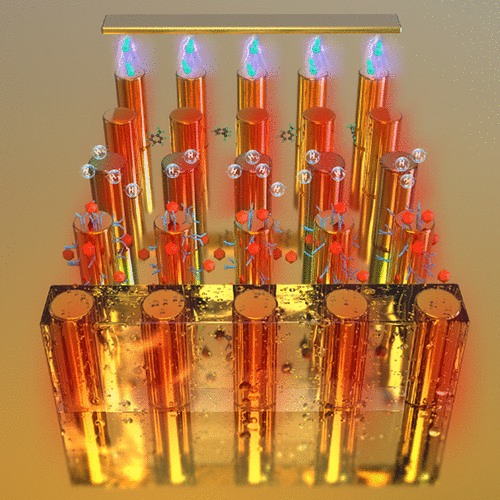当前位置:
X-MOL 学术
›
Acc. Chem. Res.
›
论文详情
Our official English website, www.x-mol.net, welcomes your
feedback! (Note: you will need to create a separate account there.)
Plasmonic Metamaterials for Nanochemistry and Sensing.
Accounts of Chemical Research ( IF 16.4 ) Pub Date : 2019-11-04 , DOI: 10.1021/acs.accounts.9b00325 Pan Wang 1, 2 , Mazhar E Nasir 1 , Alexey V Krasavin 1 , Wayne Dickson 1 , Yunlu Jiang 1 , Anatoly V Zayats 1
Accounts of Chemical Research ( IF 16.4 ) Pub Date : 2019-11-04 , DOI: 10.1021/acs.accounts.9b00325 Pan Wang 1, 2 , Mazhar E Nasir 1 , Alexey V Krasavin 1 , Wayne Dickson 1 , Yunlu Jiang 1 , Anatoly V Zayats 1
Affiliation

|
Plasmonic nanostructures were initially developed for sensing and nanophotonic applications but, recently, have shown great promise in chemistry, optoelectronics, and nonlinear optics. While smooth plasmonic films, supporting surface plasmon polaritons, and individual nanostructures, featuring localized surface plasmons, are easy to fabricate and use, the assemblies of nanostructures in optical antennas and metamaterials provide many additional advantages related to the engineering of the mode structure (and thus, optical resonances in the given spectral range), field enhancement, and local density of optical states required to control electronic and photonic interactions. Focusing on two of the many applications of plasmonic metamaterials, in this Account, we review our work on the sensing and nanochemistry applications of metamaterials based on the assemblies of plasmonic nanorods under optical, as well as electronic interrogation. Sensors are widely employed in modern technology for the detection of events or changes in their local environment. Compared to their electronic counterparts, optical sensors offer a combination of high sensitivity, fast response, immunity to electromagnetic interference, and provide additional options for signal retrieval, such as optical intensity, spectrum, phase, and polarization. Owing to the ability to confine and enhance electromagnetic fields on subwavelength scales, plasmonics has been attracting increasing attention for the development of optical sensors with advantages including both nanometer-scale spatial resolution and single-molecule sensitivity. Inherent hot-electron generation in plasmonic nanostructures under illumination or during electron tunneling in the electrically biased nanostructures provides further opportunities for sensing and stimulation of chemical reactions, which would otherwise not be energetically possible. We first provide a brief introduction to a metamaterial sensing platform based on arrays of strongly coupled plasmonic nanorods. Several prototypical sensing examples based on this versatile metamaterial platform are presented. Record-high refractive index sensitivity of gold nanorod arrays in biosensing based on the functionalization of the nanorod surface for selective absorption arises because of the modification of the electromagnetic coupling between the nanorods in the array. The capabilities of nanorod metamaterials for ultrasound and hydrogen sensing were demonstrated by precision coating of the nanorods with functional materials to create core-shell nanostructures. The extension of this metamaterial platform to nanotube and nanocavity arrays, and metaparticles provides additional flexibility and removes restrictions on the illumination configurations for the optical interrogation. We then discuss a nanochemical platform based on the electrically driven metamaterials to stimulate and detect chemical reactions in the tunnel junctions constructed with the nanorods by exploiting elastic tunneling for the activation of chemical reactions via generated hot-electrons and inelastic tunneling for the excitation of plasmons facilitating optical monitoring of the process. This represents a new paradigm merging electronics, plasmonics, photonics and chemistry at the nanoscale, and creates opportunities for a variety of practical applications, such as hot-electron-driven nanoreactors and high-sensitivity sensors, as well as nanoscale light sources and modulators. With a combination of merits, such as the ability to simultaneously support both localized and propagating modes, nanoporous texture, rapid and facile functionalization, and low cost and scalability, plasmonic nanorod metamaterials provide an attractive and versatile platform for the development of optical sensors and nanochemical platforms using hot-electrons with high performance for applications in fundamental research and chemical and pharmaceutical industries.
中文翻译:

用于纳米化学和传感的等离子超材料。
等离子体纳米结构最初是为传感和纳米光子应用开发的,但是最近在化学,光电和非线性光学领域显示出了巨大的希望。尽管光滑的等离激元薄膜,支持表面等离激元极化子和具有局部表面等离激元的单个纳米结构易于制造和使用,但光学天线和超材料中纳米结构的组装提供了与模式结构工程相关的许多其他优点(因此, ,给定光谱范围内的光学共振),场增强以及控制电子和光子相互作用所需的光学状态的局部密度。在此帐户中,重点介绍了等离子超材料的许多应用中的两个,我们回顾了基于等离子纳米棒在光学和电子询问下的超材料的传感和纳米化学应用的工作。传感器广泛用于现代技术中,以检测事件或本地环境中的变化。与电子同类产品相比,光学传感器具有高灵敏度,快速响应,抗电磁干扰的特性,并为信号检索提供了其他选项,例如光学强度,光谱,相位和偏振。由于能够在亚波长范围内限制和增强电磁场,等离激元学一直在发展具有纳米级空间分辨率和单分子灵敏度等优点的光学传感器方面引起越来越多的关注。在照明下或在电偏压的纳米结构中的电子隧穿过程中,等离激元纳米结构中固有的热电子生成为感测和刺激化学反应提供了更多的机会,否则这在能量上是不可能的。我们首先简要介绍基于强耦合等离子体纳米棒阵列的超材料传感平台。提出了几个基于该通用超材料平台的原型感测示例。金纳米棒阵列在生物传感中基于选择性吸收的纳米棒表面功能化的创纪录的高折射率灵敏度出现是由于阵列中纳米棒之间电磁耦合的改变。纳米棒超材料在超声和氢感测中的功能通过用功能性材料对纳米棒进行精密涂覆以创建核-壳纳米结构来证明。该超材料平台扩展到纳米管和纳米腔阵列,以及超微粒提供了额外的灵活性,并消除了用于光学询问的照明配置的限制。然后,我们讨论一种基于电超材料的纳米化学平台,通过利用弹性隧穿通过产生的热电子来激活化学反应,并利用非弹性隧穿来激发等离激元,从而激发和检测纳米棒构建的隧道结中的化学反应。光学监控过程。这代表了一种合并电子学的新范式,纳米级的等离子体,光子学和化学,为各种实际应用创造了机会,例如热电子驱动的纳米反应器和高灵敏度传感器,以及纳米级的光源和调制器。结合多种优点,例如能够同时支持局部和传播模式,纳米孔质地,快速简便的功能化以及低成本和可扩展性,等离激元纳米棒超材料为光学传感器和纳米化学的发展提供了一个有吸引力且用途广泛的平台高性能的热电子平台,可用于基础研究以及化学和制药行业。例如热电子驱动的纳米反应器和高灵敏度传感器,以及纳米级光源和调制器。结合多种优点,例如能够同时支持局部和传播模式,纳米孔质地,快速简便的功能化以及低成本和可扩展性,等离激元纳米棒超材料为光学传感器和纳米化学的发展提供了一个有吸引力且用途广泛的平台高性能的热电子平台,可用于基础研究以及化学和制药行业。例如热电子驱动的纳米反应器和高灵敏度传感器,以及纳米级光源和调制器。结合多种优点,例如能够同时支持局部和传播模式,纳米孔质地,快速简便的功能化以及低成本和可扩展性,等离激元纳米棒超材料为光学传感器和纳米化学的发展提供了一个有吸引力且用途广泛的平台高性能的热电子平台,可用于基础研究以及化学和制药行业。
更新日期:2019-11-04
中文翻译:

用于纳米化学和传感的等离子超材料。
等离子体纳米结构最初是为传感和纳米光子应用开发的,但是最近在化学,光电和非线性光学领域显示出了巨大的希望。尽管光滑的等离激元薄膜,支持表面等离激元极化子和具有局部表面等离激元的单个纳米结构易于制造和使用,但光学天线和超材料中纳米结构的组装提供了与模式结构工程相关的许多其他优点(因此, ,给定光谱范围内的光学共振),场增强以及控制电子和光子相互作用所需的光学状态的局部密度。在此帐户中,重点介绍了等离子超材料的许多应用中的两个,我们回顾了基于等离子纳米棒在光学和电子询问下的超材料的传感和纳米化学应用的工作。传感器广泛用于现代技术中,以检测事件或本地环境中的变化。与电子同类产品相比,光学传感器具有高灵敏度,快速响应,抗电磁干扰的特性,并为信号检索提供了其他选项,例如光学强度,光谱,相位和偏振。由于能够在亚波长范围内限制和增强电磁场,等离激元学一直在发展具有纳米级空间分辨率和单分子灵敏度等优点的光学传感器方面引起越来越多的关注。在照明下或在电偏压的纳米结构中的电子隧穿过程中,等离激元纳米结构中固有的热电子生成为感测和刺激化学反应提供了更多的机会,否则这在能量上是不可能的。我们首先简要介绍基于强耦合等离子体纳米棒阵列的超材料传感平台。提出了几个基于该通用超材料平台的原型感测示例。金纳米棒阵列在生物传感中基于选择性吸收的纳米棒表面功能化的创纪录的高折射率灵敏度出现是由于阵列中纳米棒之间电磁耦合的改变。纳米棒超材料在超声和氢感测中的功能通过用功能性材料对纳米棒进行精密涂覆以创建核-壳纳米结构来证明。该超材料平台扩展到纳米管和纳米腔阵列,以及超微粒提供了额外的灵活性,并消除了用于光学询问的照明配置的限制。然后,我们讨论一种基于电超材料的纳米化学平台,通过利用弹性隧穿通过产生的热电子来激活化学反应,并利用非弹性隧穿来激发等离激元,从而激发和检测纳米棒构建的隧道结中的化学反应。光学监控过程。这代表了一种合并电子学的新范式,纳米级的等离子体,光子学和化学,为各种实际应用创造了机会,例如热电子驱动的纳米反应器和高灵敏度传感器,以及纳米级的光源和调制器。结合多种优点,例如能够同时支持局部和传播模式,纳米孔质地,快速简便的功能化以及低成本和可扩展性,等离激元纳米棒超材料为光学传感器和纳米化学的发展提供了一个有吸引力且用途广泛的平台高性能的热电子平台,可用于基础研究以及化学和制药行业。例如热电子驱动的纳米反应器和高灵敏度传感器,以及纳米级光源和调制器。结合多种优点,例如能够同时支持局部和传播模式,纳米孔质地,快速简便的功能化以及低成本和可扩展性,等离激元纳米棒超材料为光学传感器和纳米化学的发展提供了一个有吸引力且用途广泛的平台高性能的热电子平台,可用于基础研究以及化学和制药行业。例如热电子驱动的纳米反应器和高灵敏度传感器,以及纳米级光源和调制器。结合多种优点,例如能够同时支持局部和传播模式,纳米孔质地,快速简便的功能化以及低成本和可扩展性,等离激元纳米棒超材料为光学传感器和纳米化学的发展提供了一个有吸引力且用途广泛的平台高性能的热电子平台,可用于基础研究以及化学和制药行业。











































 京公网安备 11010802027423号
京公网安备 11010802027423号